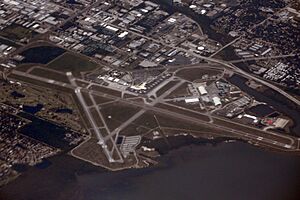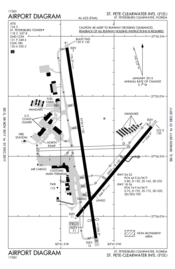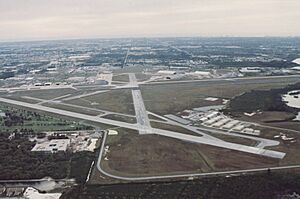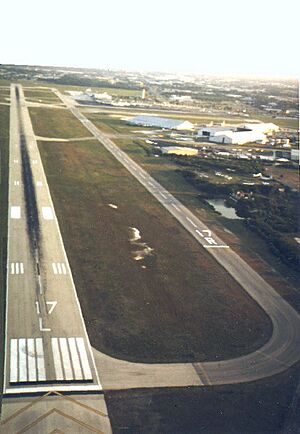St. Pete–Clearwater International Airport facts for kids
Quick facts for kids
St. Pete–Clearwater International Airport
|
|||||||||||||||
|---|---|---|---|---|---|---|---|---|---|---|---|---|---|---|---|
 |
|||||||||||||||

Aerial view of the airport in 2010
|
|||||||||||||||
| Summary | |||||||||||||||
| Airport type | Public | ||||||||||||||
| Owner | Pinellas County | ||||||||||||||
| Serves | Tampa Bay Area | ||||||||||||||
| Location | Unincorporated Pinellas County, adjacent to Pinellas Park | ||||||||||||||
| Elevation AMSL | 11 ft / 3 m | ||||||||||||||
| Coordinates | 27°54′36″N 082°41′15″W / 27.91000°N 82.68750°W | ||||||||||||||
| Map | |||||||||||||||
 FAA airport diagram |
|||||||||||||||
| Runway | |||||||||||||||
|
|||||||||||||||
| Statistics (2023) | |||||||||||||||
|
|||||||||||||||
|
Sources: FAA, airport website
|
|||||||||||||||
St. Pete–Clearwater International Airport (PIE) is a public airport in Pinellas County, Florida, USA. It serves the Tampa Bay Area. The airport is located near Pinellas Park. It is about 9 miles (14 km) north of downtown St. Petersburg. It is also 7 miles (11 km) southeast of Clearwater.
The Federal Aviation Administration (FAA) calls it a "small-hub primary commercial service facility." This means it's an important airport for flights. In 2014, the airport saw a big increase in passengers. It handled over one million travelers that year.
Most flights in the Tampa Bay Area use Tampa International Airport (TPA). TPA is about 10 miles (16 km) east. However, St. Pete–Clearwater is popular for airlines that offer lower prices. Allegiant Air uses PIE as a main base for its flights. The airport is also less busy than Tampa. This makes it a good choice for private planes and business jets.
The airport uses the slogan "Tampa Bay The Easy Way." It also uses "Fly2PIE" because of its airport code, PIE.
Contents
Airport History
The airport is on the west side of Tampa Bay. It is 6 miles (10 km) north of St. Petersburg, Florida. St. Petersburg is known as the "birthplace of commercial air transportation."
The First Commercial Flight
Just ten years after the Wright brothers flew in 1903, the first airline tickets were sold. This happened in 1914. The St. Petersburg-Tampa Airboat Line was started by Tony Jannus. He sold tickets to people who wanted to fly.
The first flight took off from near the downtown St. Petersburg Pier. It used a Benoist XIV amphibious aircraft. The first passengers were Mayor Abram C. Pheil and Mae Peabody. They flew across the bay to Tampa. Reports say they reached a speed of 75 miles per hour (121 km/h). They also flew as high as 50 feet (15 meters).
This flight was the start of commercial air travel around the world. A copy of the Benoist aircraft is on display at the airport. You can see it in the baggage claim area. There is also a plaque to remember this event. Another copy of the plane is at the St. Petersburg Museum of History. The airport terminal also keeps old records of Florida's aviation history.
Building and War Efforts
Work on the airport started in March 1941. After the attack on Pearl Harbor, the United States Army Air Forces took over the airport. They used it as a training base for pilots. It was part of the Third Air Force.
During World War II, the 304th Fighter Squadron was based here. They trained pilots to fly P-40 Warhawk and P-51 Mustang planes. The airport was then called Pinellas Army Airfield. Planes also flew from here to look for German U-boats in the Gulf of Mexico.
In 1994, a plaque was placed at the airport terminal. It honors the airport's role in the war. It also remembers Brigadier General James H. Howard. He was a famous fighter pilot in World War II. He was also the last wartime commander of the airfield. There is a special display at the terminal about General Howard.
After the War
After World War II, the U.S. government gave the airport back to Pinellas County. It was meant to be a public airport. It was first named Pinellas International Airport. It got the airport code PIE. This code is still used today.
In 1958, the name changed to St. Petersburg–Clearwater International Airport. This was because tourists did not know where Pinellas County was.
Airline Flights: 1950s to Mid-2000s
From the 1950s to the mid-1960s, many big airlines flew to PIE. These included Delta Air Lines, Eastern Air Lines, and National Airlines. In 1957, there were 17 flights leaving PIE each day.
When jet planes became common, runway 17/35 was made longer. It stretched into Tampa Bay. The first jet flights started in late 1961. These were Northwest Airlines Boeing 720Bs from Chicago.
In the early 1960s, officials decided that most jet flights for the Tampa Bay area should go to TPA. Eastern Air Lines was the last airline to offer regular flights from PIE. They stopped in 1964.
Regular flights came back to PIE in 1972. Air Florida started flying Boeing 707s to Miami and Orlando. Over the years, other airlines like Northeastern International Airways and People Express also offered jet flights. They flew to places like New York.
In the 1990s, American Trans Air (ATA) and Air South started flying jets from PIE. ATA flew to Chicago, Indianapolis, and even Nassau, Bahamas. By 2005, five airlines were flying jets to PIE. These included ATA Airlines and USA 3000 Airlines.
Newer Changes
In September 2006, Allegiant Air started new flights from PIE. They added service to many cities in the eastern United States. Today, Allegiant flies to 59 airports from PIE. They use A319 and A320 jets.
In 2009, the airport finished a big upgrade. It cost $22 million. This included bigger gates and new jet bridges for passengers.
In 2021, the airport planned to change an old runway. Runway 9/27 will become a taxiway. This will help planes move around better. It will also help the U.S. Coast Guard and Pinellas County Sheriff's Office aircraft.
Airport Features
The airport covers 1900 acres (769 hectares). It is 11 feet (3 meters) above sea level. It has two asphalt runways:
- Runway 18/36: 9,730 feet (2,966 m) long and 150 feet (46 m) wide. It has an ILS for landings.
- Runway 04/22: 6,000 feet (1,829 m) long and 150 feet (46 m) wide.
PIE is also home to Coast Guard Air Station Clearwater. This is the largest U.S. Coast Guard Air Station in the United States. They fly large HC-130 Hercules planes and MH-60T Jayhawk helicopters.
The U.S. Army Reserve also has a base at PIE. They use UH-60 Blackhawk helicopters.
Other important services at the airport include:
- U.S. Customs and Border Protection
- The Federal Aviation Administration (FAA) control tower
- The FAA's Automated Flight Service Station (AFSS), which is very busy.
- The St. Petersburg VORTAC for air navigation.
The entire airport area is a Foreign Trade Zone (FTZ). This means special rules apply to goods here. A large Airport Industrial Park was built in the 1980s. It is a big business center. The airport and its businesses employ over 3,000 people. They bring over $400 million to the Tampa Bay area each year.
The airport has a 24-hour airport rescue and fire-fighting (ARFF) team. They also have staff for operations, facilities, and security.
In 2021, the airport had 146,494 aircraft movements. This means about 401 planes took off or landed each day. Most of these (78%) were general aviation flights. About 10% were commercial flights.
Special Events
Every year, St. Petersburg–Clearwater International Airport hosts the Honor Flight of West Central Florida. This event helps American veterans fly to Washington D.C. There, they visit memorials for those who served in wars. About 75 to 80 older veterans take part each year. This program helps veterans who might not be able to visit D.C. otherwise.
Terminal Areas
St. Petersburg–Clearwater International Airport has one main terminal. It has two gate areas: A-Side and B-Side.
- A-Side has gates 1-6.
- B-Side has gates 7-12.
Gates 1 and 12 are only for arriving flights. Gate 1 leads to the ticketing area. Gate 12 leads to the baggage claim.
Airlines and Destinations
| Airlines | Destinations |
|---|---|
| Allegiant Air | Akron/Canton, Albany (NY), Allentown, Appleton, Asheville, Bangor, Belleville/St. Louis, Bismarck, Bloomington/Normal, Cedar Rapids/Iowa City, Charlotte/Concord, Chattanooga, Chicago/Rockford, Cincinnati, Clarksburg, Columbus–Rickenbacker, Dayton, Des Moines, Elmira, Evansville, Fayetteville/Bentonville, Flint, Fort Wayne, Grand Rapids, Greensboro, Greenville/Spartanburg, Harrisburg, Huntington (WV), Indianapolis, Kansas City, Key West, Knoxville, Lexington, Louisville, McAllen, Memphis, Nashville, Newburgh, Niagara Falls, Omaha, Peoria, Pittsburgh, Roanoke, Savannah (begins November 15, 2024), Sioux Falls, South Bend, Springfield/Branson, Syracuse, Toledo, Traverse City, Tulsa, Wichita Seasonal: Fargo, Hagerstown, Little Rock, Moline/Quad Cities, Norfolk, Plattsburgh, Portsmouth, Provo, Richmond, Tri-Cities (TN) |
| Sun Country Airlines | Seasonal: Minneapolis/Saint Paul |
| Destinations map |
|---|
Airport Statistics
| Rank | Carrier | Passengers | Market Share |
|---|---|---|---|
| 1 | Allegiant | 2,419,000 | 99.02% |
| 2 | Sun Country | 24,030 | 0.98% |
Top Places People Fly To
| Rank | City | Passengers | Carriers |
|---|---|---|---|
| 1 | 68,370 | Allegiant | |
| 2 | 61,310 | Allegiant | |
| 3 | 53,980 | Allegiant | |
| 4 | 51,840 | Allegiant | |
| 5 | 41,580 | Allegiant | |
| 6 | 40,550 | Allegiant | |
| 7 | 38,420 | Allegiant | |
| 8 | 34,690 | Allegiant | |
| 9 | 27,570 | Allegiant | |
| 10 | 27,080 | Allegiant |
Yearly Passenger Numbers
| Year | Passengers | Year | Passengers | Year | Passengers |
|---|---|---|---|---|---|
| 2004 | 1,333,069 | 2014 | 1,247,987 | 2024 | |
| 2005 | 596,510 | 2015 | 1,645,402 | 2025 | |
| 2006 | 389,997 | 2016 | 1,837,035 | 2026 | |
| 2007 | 747,369 | 2017 | 2,055,269 | 2027 | |
| 2008 | 742,380 | 2018 | 2,237,446 | 2028 | |
| 2009 | 776,535 | 2019 | 2,288,692 | 2029 | |
| 2010 | 776,087 | 2020 | 1,394,573 | 2030 | |
| 2011 | 833,068 | 2021 | 2,036,251 | 2031 | |
| 2012 | 865,942 | 2022 | 2,445,919 | 2032 | |
| 2013 | 1,017,049 | 2023 | 2,494,952 | 2033 |
Past Incidents
- On January 10, 1955, a National Airlines plane (Lockheed Lodestar) was leaving for Sarasota. The co-pilot lost control, and the plane went off the runway. All 13 people on board were safe. The plane was too damaged to be fixed.
- On May 30, 1969, a USAF Lockheed C-130E Hercules plane was badly damaged in an incident on the ground.
- On June 6, 1982, a Douglas C-47 plane crashed during a training flight. All 5 people on board survived, but the plane was destroyed.
- On September 30, 2015, the pilot of a Piper PA-30 plane crashed and died. This happened while practicing takeoffs and landings.
- On January 4, 2016, a Beechcraft 200 Super King Air plane landed without its landing gear down. The pilot survived, but the plane was heavily damaged.
See also
 In Spanish: Aeropuerto Internacional de San Petersburgo-Clearwater para niños
In Spanish: Aeropuerto Internacional de San Petersburgo-Clearwater para niños






